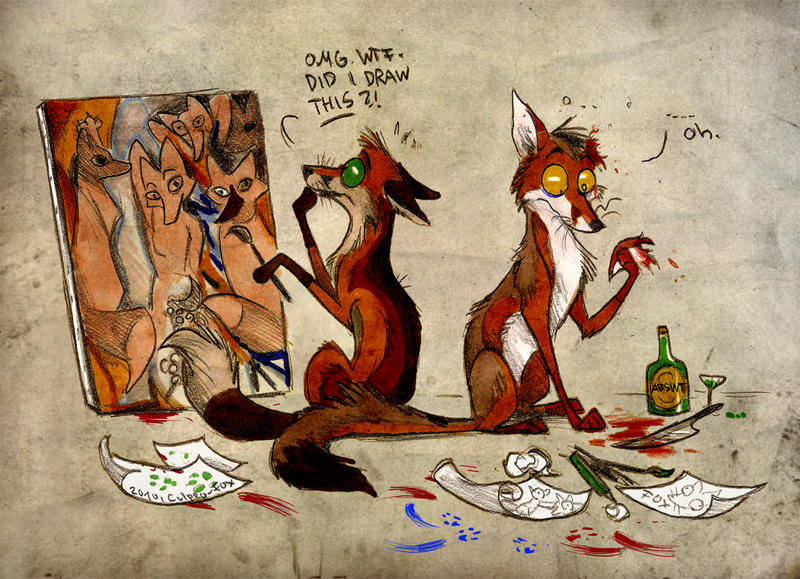Tagged: creativity
Out of Madness Comes Life: Are The Arts Crazy?
Sometimes, writing is tough. The passion isn’t there, and every word is a struggle. We’ve all had those moments when forced to do something artistic or creative, whether it be writing or drawing or playing an instrument (or anything really). We’re just not into it, we don’t feel the pulse of the art pounding in our blood. Yet at other times, it’s like our blood rushes in a massive torrential pour, as if it had been held back by a massive dam for a thousand years. Whether its a subject that makes you jump for joy, a song you can head-bang to, or some other Picasso, some things just burst forth in a sudden and fervent explosion of productivity and creativity.

A Tongue Twister: Are Artists' Artistry Artful?
I think we’ve all had those moments when the pieces all click together, and a piece of work flows from us as easily as a hot knife through butter. During those moments, we feel alive, throbbing with a vibrant energy as our whole being is focused onto a single task. It’s an exhilarating feeling, yet at the same time, when you finally come down out of this strange natural high, it feels as though there was something slightly wrong about that, as if those who are capable of reaching that level often must have something wrong with them.
More
LSD and Creativity
In 2007, Albert Hofmann, the creator of lysergic acid diethylamide (LSD), wrote a letter to Steve Jobs on behalf of his friend Rick Doblin, who was the founder of the nonprofit organization Multidisciplinary Association for Psychedelic Studies (MAPS). Hofmann was with hopes, at the age of 101, that Jobs might want to make a donation to support Swiss psychiatrist Dr. Peter Gasser's proposed study of LSD-assisted psychotherapy. The main mission of MAPS is to develop psychedelics and marijuana into prescription drugs that could be made available to treat people with post-traumatic stress disorder (PTSD), pain, drug dependence, anxiety, and depression. Hofmann, a large supporter of the organization, pushed the idea that his creation has helped others and could provide crucial benefits in future health treatments and so asked Jobs for "help in the transformation of [his] problem child into a wonder child." Many others who have had the opportunity to experiment with this psychedelic drug brought on an entirely different perspective of what LSD provides: an awakening of the Self and for many innovative thinkers an eye-opening journey in expanding their creativity. More
Jazz in an fMRI? An Innovative Look at Creativity and the Brain
We’ve all been exposed to jazz at one time or another—whether it be the musings of an accomplished jazz pianist or the improvisational skills of a saxophone player, jazz is something that’s familiar to us. But, when enjoying such a piece of music, we may not have considered the effect it has on the musician’s brain.
Charles Limb, musician and researcher at Johns Hopkins University, is specifically interested in the workings of the brain during musical improvisation. In order to better understand these mechanisms, he studied the brains of accomplished jazz musicians playing music in an fMRI machine.

The two pillars of his study—playing music which has been memorized and over-learned, and playing music which has been entirely improvised—were designed to pinpoint which brain regions were most active in each situation, as well as to see how differing amounts of creativity play a role in brain activity. Limb asked participants to first play a memorized piece of music on a specially designed keyboard, and then to improvise based on the scale progression of the previous piece.
What he found was quite interesting.
In the studies, Limb observed that, compared to the fMRI of brains playing memorized music, those playing improvised music typically had a higher amount of activation in the medial prefrontal cortex, an area attributed to self-expression, and a lower amount of activation in the lateral prefrontal cortex, an area attributed to self-monitoring. He postulates that in order for an individual to be creative, they must exhibit a sort of dissociation in the frontal lobe by which the large part of the brain controlling self-monitoring is not inhibiting self-expression of new, free-flowing ideas.
More recently, Limb has been studying another form of improvisational music, which he believes serves a similar social function to that of jazz—hip-hop. To do this, he has recruited the talents of accomplished hip-hop artists from the Baltimore hip-hop scene and studied their brain activity while they rap. The structure of the study is similar to that of the jazz pianists in that it was separated into two parts—one to study brain activity while performing a memorized piece and one to study brain activity while improvising. The participants were asked first to rap a piece written by Limb (which they had not seen before), and then to improvise based on a guideline of periodically prompted words. Though the study is not yet complete and no conclusive results are available, what Limb has seen so far has been quite promising.
Outside of Limb's unique research, no extensive work has been done yet to study these phenomena. However, these results prove to be very promising in that they can offer new ways to think about creativity and the brain. Perhaps sometime in the future, with more sophisticated methods of brain imaging, it will be possible to understand the workings of the brain in other creative realms, such as dance. These and many other questions are coming closer to having answers.
Charles Limb: Your Brain on Improv - Video on TED.com
TED Blog - Hip-hop, creativity and the brain: Q&A with Dr. Charles Limb